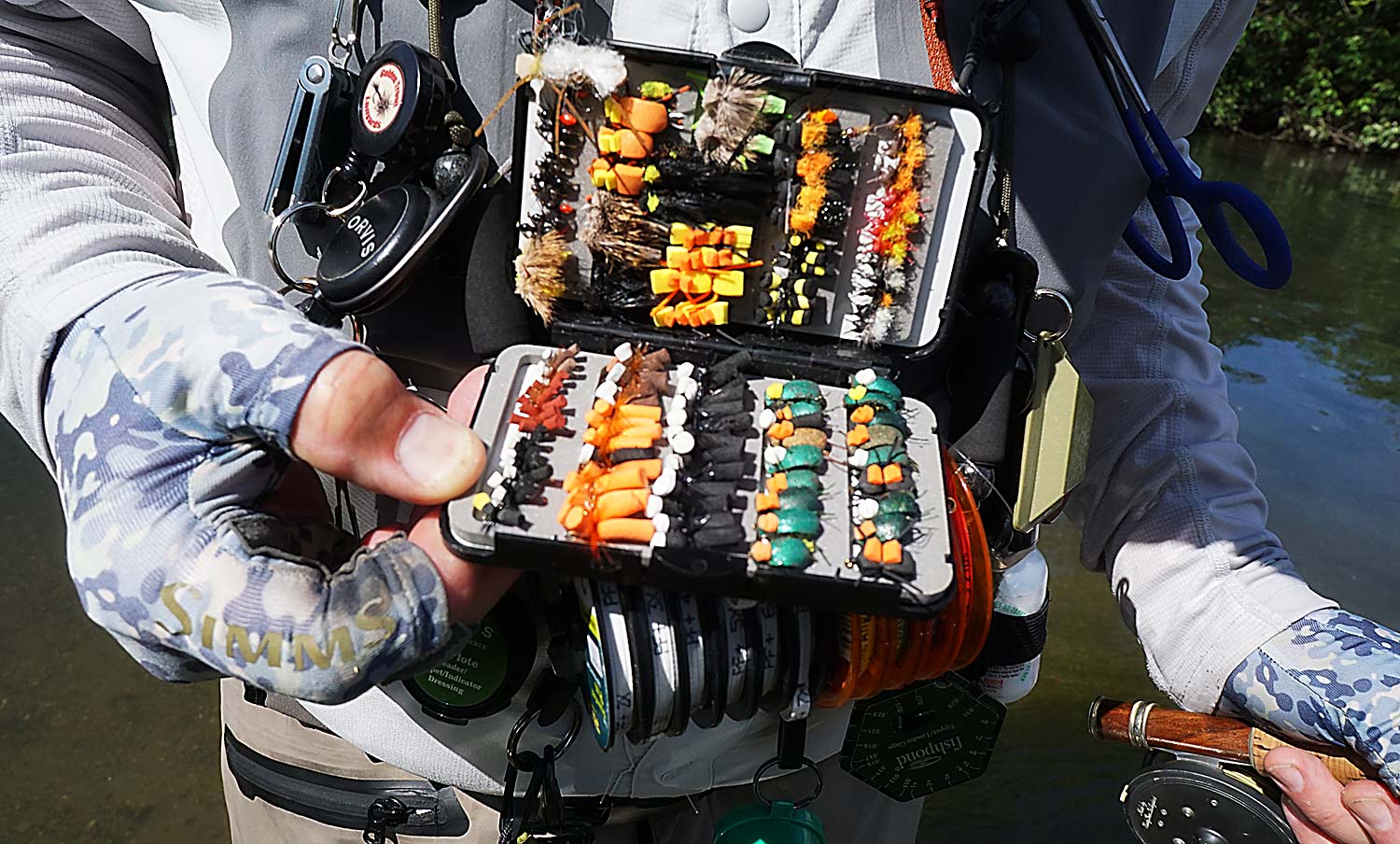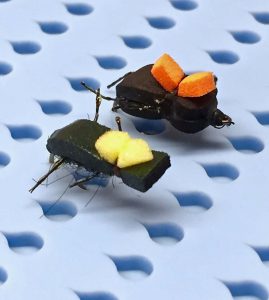
Photo by George Daniel
By George Daniel
Beetles that Create Impact On Trout Streams
A fly fisher’s job is to gain “positive” attention from the fish they pursue. In this instance, we’re going to focus on trout and terrestrial patterns. Positive attention occurs when a pattern creates enough impact on the water surface to arouse curiosity (not fear) in a feeding trout. Focus on presentation and good technique is always of the top of the list, but sometimes the right patterns can make all the difference. I’m still a firm believer that technique trumps pattern choice, but there’s always exceptions.
One reason I guide is for the lessons I learn through the power of observation. It’s my job to try to help coach individuals into catching fish, but so often I’m the one taking home the lesson of the day. In the case of this article, I’m referring to the time I spend with longtime fishing guest/client Bob Williams. First, let me make it clear that Bob “The Beetle” Williams doesn’t need a guide. He’s one of the most well rounded terrestrial fly fishers I’ve met. I am grateful for the fun times we have had on the water and thankful for the lessons I’ve gleaned over the years.
One such lesson is that, not all fly tying foams are created equal. Long story short, the density built into a terrestrial can make the difference between getting no attention or receiving positive attention. Several years ago, Bob showed me a dense foam material manufactured by a local PA guy and it totally changed my opinion on the importance of how a pattern lands on the water. What I’m getting at is, there are times when your patterns need to create such an intense impact that trout can feel the fly land, even if they cannot see it. Common sense, I know, but sometimes we can all use a refresher course in terrestrial fishing 101.
Think about deep undercut banks where trout will hold. Trout holding deep under the bank often cannot see what’s going on outside their lair, and a terrestrial pattern that is designed to land softly on the water is not likely to garner a trout’s attention. For years I only guided with one beetle pattern, tied with the standard foam that all fly shops sell. It worked well enough so I stuck with it until my first trip with Bob. Then Bob introduced a foam beetle material he bought from Bill Skillton years ago. A rigid foam strip coated with a material that drastically increased its density.
Watching the effect it had on the local trout forever changed my opinion on fishing undercut banks with terrestrials.
After having little success fishing my foam pattern along a prime section of undercut bank, Bob asked to head back downstream fish back through the same water with his beetle instead. Within several casts, Bob was getting fish to come out from the bank to investigate the pattern, in the same locations where we hadn’t seen any fish look at my pattern. Why? My rational was because the density of Bob’s Pattern allowed the fish holding under the bank to feel the fly land on the water. In most cases, I’d hear the pattern “plop” on the water. It was getting attention where my pattern wasn’t.
Now don’t get me wrong, I still use regular foam for many terrestrial patterns, but I purposely fish denser patterns near undercut banks where I want to create an impact on the water for fish holding in sheltering lies.

The bottom Fly is the original Bill Skilton Beetle. Notice the metallic foam. This fly only has one foam layer but has incredible density due to the impregnated foam.
The top Fly is the Bob Williams current go to beetle. It’s a beetle variation he picked up from Theo Bakelaar during the International Fly Tying Symposium. This double layer beetle also creates impact when landing on the water.
This concept of high impact is not new.
I can recall reading that legendary Pennsylvania angler George Harvey used cork for his ant patterns in the 1930s for the same reasons. Unfortunately, it appears Bill Skillton is no longer producing this foam material. Hopefully one day someone will again manufacture a similar style of foam, or create preformed cork terrestrial bodies, or develop an entirely new dense material for tying terrestrials.
Until that time comes, here’s several suggestions for achieving greater impact (aside from more aggressive casting):
- Add several wraps of small led wire into your terrestrial pattern. Often 10-12 wraps of .015 is enough to get the job done.
- Add UV Coating to the top of the foam to increase density.
- Although a bit more difficult to cast, Bob is now using a beetle pattern developed by Theo Bakelaar. It’s a double layered foam beetle that creates more impact than most beetle patterns. The material used is distributed by Renzetti Online and is called Foam Beetle Body. Unless you can get your hands on some Bill Skilton’s beetle foam, this variation is one of the best “impactful’ beetle patterns I’ve seen in recent years.
I’d like to thank Bob Williams for sharing his passion for terrestrial fishing with me over the years. I hope this simple concept adds to your enjoyment as well.
George Daniel https://www.livinonthefly.com Gink & Gasoline www.ginkandgasoline.com hookups@ginkandgasoline.com Sign Up For Our Weekly Newsletter!
Casting technique can also increase the impact of a foam beetle. The force of the beetle landing (“plop”) can be varied this way without changing patterns. Using water absorbent underbody works too; the more water the bigger the impact. A very interesting read; thanks.
I feel like beetles and ‘hoppers should be delivered, not with finesse, but as they they fell off a cliff…
Gary LaFontaine conducted thorough grasshopper studies. He strongly recommended the use of a skip cast delivery which starts with a violent strike but ends with a much softer plop.
Pingback: Sudden Impact, Fishing A Better Beetle